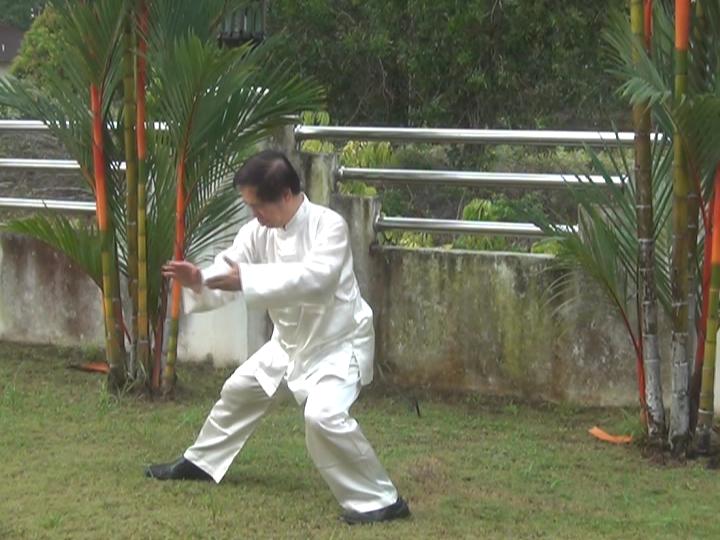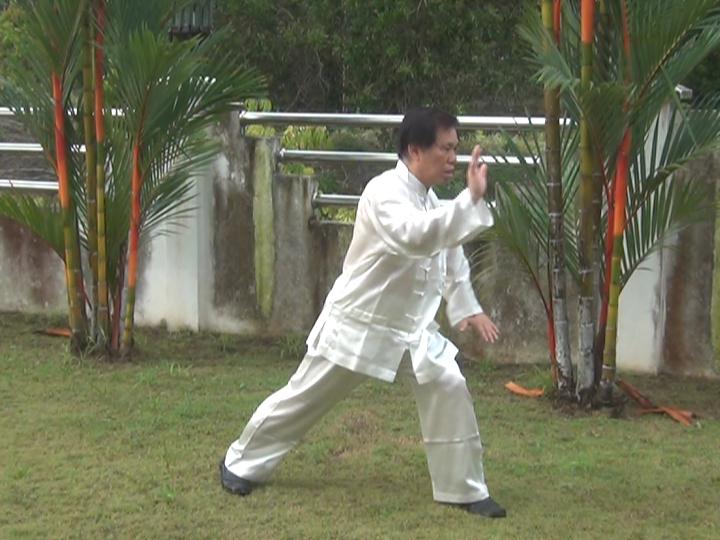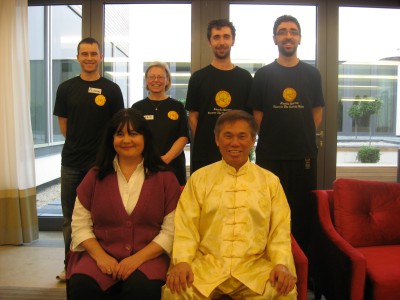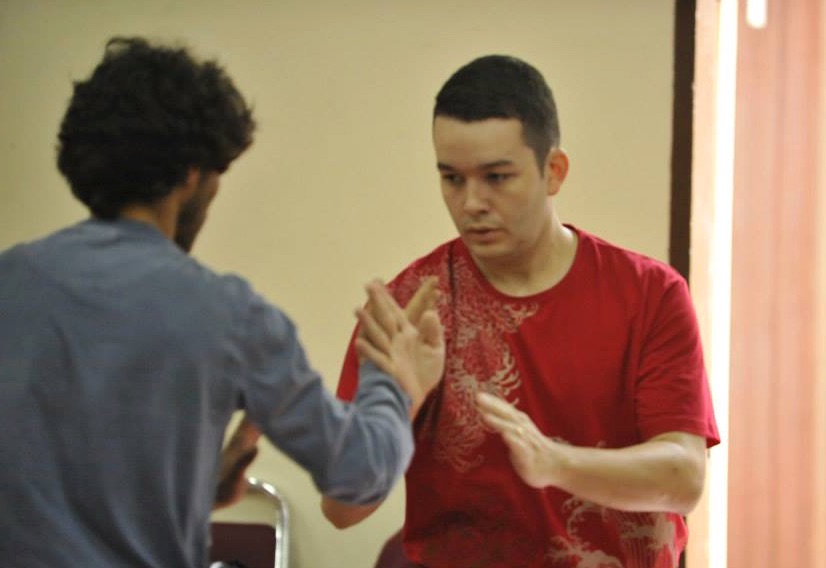REASONS FOR AND BENEFITS OF SOFTNESS IN TAIJIQUAN

Yang Style Taijiquan is the softest of kungfu styles
Question 3
I believe that the Yang 108-Pattern Set is one of the softest sets in our syllabus. Please can you talk about the reasons for this emphasis on softness, and the particular benefits that go along with it?
Sifu Andy Cusick, Shaolin Wahnam Glasgow
Answer
Yes, the Yang Style 108-Pattern Set is the softest set in our repertoire. It is also the softest in all kungfu.
In my young days I learned a Cotton Palm set from my sidai, Sifu Yeung Khun Chi, the Grandmaster of Chin Woo Athletic Association, Georgetown, Penang, who also taught me Tantui, Eagle Claw and Praying Mantis, in exchange for some chi kung and combat applications I taught him.
I only learned the physical form of the Cotton Palm set. After reading from kungfu classics, and learning Cosmos Palm from Sifu Ho Fatt Nam, and Wuzuquan from Sifu Chee Kim Thong, who also knew Cotton Palm, I concluded that the internal force of Cosmos Palm, Cotton Palm and Red Sand Palm was similar. If this is true, then the Yang Style 108-Pattern Set is even “softer” than the Cotton Palm set.
If we list our representative sets from the softest to the hardest, they will be as follows.
Yang Style Set – San Zhan – Baguazhang – Flower Set – Dragon Strength – Wudang Taijiquan – Flowing Water Floating Clouds – Siu Lin Tou – Xingyiquan - .Triple Stretch – Iron Wire
The main reason for this emphasis on softness is historical. When Yang Deng Fu invented this set from Chen Style Taijiquan, he meant it for health. Reviewing the transformation of Chen Style Taijiquan to Yang Style Taijiquan, we can see that Yang Deng Fu did three things:
1. He rounded the movements, making linear movements circular.
2. He enlarged the movements, making them bigger.
3. He performed the movements slowly.
All these innovations made Taijiquan soft.
If you, for example, perform the linear movement of Beauty Looks at Mirror in a circular manner, it becomes softer.
If you perform Beauty Looks at Mirror, still in linear fashion, in a bigger movement, it becomes softer.
If you perform the same movement more slowly, it becomes softer.
Because of exponential progression, the same liner, short and fast Beauty Looks at Mirror performed in a circular, bigger and slow manner becomes nine times softer.
The main benefit of softness is health. Indeed, chi kung for health is sometimes referred to as soft chi kung, whereas chi kung for combat as hard chi kung.
We can immediately feel health related benefits by performing the following simple exercise.
Make a linear palm strike, like bending your elbow and thrust out your palm in a linear fashion.
Now make a circular palm strike, without bending your elbow by circulating your whole arm from your shoulder.
Don’t you feel more relaxed with the circular movement? If you listen to yourself more attentively, you may also feel mentally fresher.
Next, perform the circular arm movement of the palm strike in a small circle. Compare it by performing the same movement in a big circle. If you add waist rotation, it is even better. Do you feel any difference? You were relatively tighter with the small circle, and more loosened with the big circle – physically, emotionally, mentally and spiritually.
Now perform the circular movement -- in small circle, big circle or both –fast and compare it by performing slowly. What difference can you feel? When a person performs a movement fast, unless he is trained in genuine chi kung like we do, he tends to tense his muscles. When he performs the same movement slowly, he is more relaxed. Even for us trained in chi kung, we can feel a difference.
If we can discernably feel the difference by performing this exercise only once for a few minutes, imagine the huge difference by performing Taijiquan the soft way in contrast with the hard way an hour a day, every day for ten years.

Soft movements in Taijiquan generate a smooth chi flow
The great benefit, by a very big margin, however, is not just being loosened, relaxed and mentally fresh, but to generate an energy flow. As we in Shaolin Wahnam know very well, it is the energy flow that overcomes pain, injury and illness, and gives us good health, vitality and longevity.
An even greater benefit is to attain a chi kung state of mind, or in Taijiquan terms, to enter Tao, or in modern terms to attain a higher state of consciousness. At the fundamental level, this enables us to be peaceful and happy. At the supreme level, it enables us to merge with Tao or return to God the Holy Spirit. And there are countless benefits in between.
It may be a big surprise to many people that despite being the inventor of this wonderful Yang Style 108-Pattern Set, Yang Deng Fu did not enjoy the many wonderful benefits described above, except vitality. It must be realized that we state the truth, though it may not be widely known, and we are not afraid to do so, but it does not distract us from our respect and honour we give to this great Taijiquan master, whose innovations have benefitted us tremendously.
Yang Deng Fu was not healthy -- physically and emotionally! He sustained an internal injury from his father’s or uncle’s strike while training that he had to carry for life. He was also notorious for his bad temper. Once when someone annoyed him, he killed the person with just one strike.
His childhood was not happy and he did not enjoy his training. Once he ran away from home to avoid the rigorous training of his secretive family Taijiquan.
He did not live long. He passed away before he reached sixty.
There was no doubt that he had a lot of internal force and was a terrific fighter. Why didn’t he enjoy the benefits of his internal force, except to enhance his fighting ability which did not make his life happier or even easier?
The main reason was that he lacked the philosophy of Taijiquan that we have. He did not know the three functions of internal force that we do, and he did not know that it was chi flow that gives the wonderful benefits of overcoming pain, injury and illness, and gives good health, vitality and longevity. Even if he knew, he did not realize it. Thus, this wisdom and its resultant benefits are not passed down his lineage.
The most important of the three functions of internal force is to maintain life, which includes overcoming pain, injury and illness. It is chi flow, not the Taijiquan movement, that brings about these benefits.
It is quite shocking that many Yang Style practitioners today, especially in the West, sustain knee injury. I believe this is due to wrong teaching. Many instructors fail to teach rotation of the waist, which is very important in Taijiquan mechanics. As a result students shift their body forward with their knees moving in a linear manner.
It is also surprising that hardly any of the thousands of thousands of Yang Style Taijiquan practitioners all over the world have internal force. Indeed I posed this question to some instructors over meals during the recent Wudang Taijiquan course. The forms performed by thousands of Taijiquan practitioners, especially those of Yang Style, are technically correct. They practice the forms slowly, gracefully and dedicatedly. Why hardly any of them have internal force even whey they have practiced daily for over 10 years?

The softness of Taijiquan brings good health and vitality
We do not expect them to be as cost-effective as ourselves. Our students, even fresh beginners, can feel internal force after just one session, or at the most after one month of regular class. Other students even when their techniques are correct and they perform the forms slowly and gracefully without thinking of irrelevant thoughts still cannot develop any internal force after 10 years!
Mark Blohm was kind to suggest that it was because of the teacher, implying me. Andrea Zilio said that the other students did not have chi flow.
These are excellent answers. A good teacher will be able to help his students to have a chi flow, if not in one month at least in one year. Even if a good teacher is not available, students practicing the techniques and skills correctly should have a chi flow after a few years. The problem is that they do not realize the essential ingredient for the benefits is chi flow with the result that their chi flow which happens haphazardly is not regular and strong enough to bring them the benefits.
We are ridiculously generous. We offer them this golden opportunity, like the Yang Style 108-Pattern course in Ireland. We even go to the extend to say that these students do not have to acknowledge they have learnt from us. We sincerely want them to restore the greatness of their art. But if they choose not to make use of the opportunity, it is their business.
Developing internal force which brings good health, vitality and longevity is only half the task of training Taijiquan as an internal martial art. The other half, besides the internal, is the martial aspect. Hence, in all our Taijiquan training, we pay importance to combat application.
We do so not because we aspire to be terrific fighters, though we are good at fighting if the need arises, but because martial training brings our attainment of good health, vitality and longevity to a higher level. In our law-abiding society, an average person does not have to fight even once a year. Dedicating ourselves to such a rare eventuality is not a wise use of time. But having good health, vitality and longevity affects us everyday of our life. It is wise to bring such attainments to a higher level.
An ordinary person is quite happy if he is free from pain, injury and illness. But the health demand of a martial artist is more than this. He needs, for example, to make quick decisions and execute fast movements. An ordinary person is quite happy if he can sit and watch a game of football or any sport. The vitality demand of a martial artist is higher. He wants to be able to run and jump for an hour or two and not panting for breath and not being tired. An ordinary person is happy if he lives to 90 and be respected as an elderly person. A martial artist lives to 90 and feels and acts younger than others who are 60.
If we perform Taijiquan movements, like those of the Yang Style 108-Pattern Set, in circular and big forms slowly, we can attain the health aspects, but not the martial aspect. To attain the martial aspect without neglecting the health aspects, or to attain yin-yang harmony, we have to transform big circular movements performed slowly to small smooth movements performed fast.
Students at the recent Wudang Taijiquan course in Penang learned the required philosophy, techniques and skills for this transformation. Students of the Yang Style 108-Pattern Set in Ireland will also learn the required philosophy, techniques and skills, which will bring a lot of benefits not only to Taijiquan but also to their daily life.
Grandmaster Wong Kiew Kit
17th December 2013

Training the martial aspect of Taijiquan brings health and vitality to a higher level
The question and answer are taken from the thread Yang 108-Pattern Set: 10 Questions for the Grandmaster in the Shaolin Wahnam Institute Discussion Forum.
